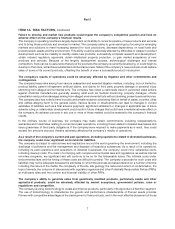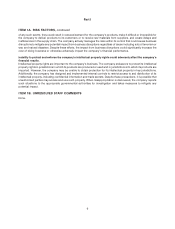DuPont 2009 Annual Report Download - page 18
Download and view the complete annual report
Please find page 18 of the 2009 DuPont annual report below. You can navigate through the pages in the report by either clicking on the pages listed below, or by using the keyword search tool below to find specific information within the annual report.Part II
ITEM 7. MANAGEMENT’S DISCUSSION AND ANALYSIS OF FINANCIAL CONDITION AND
RESULTS OF OPERATIONS
CAUTIONARY STATEMENTS ABOUT FORWARD-LOOKING STATEMENTS
This report contains forward-looking statements which may be identified by their use of words like ‘‘plans,’’ ‘‘expects,’’
‘‘will,’’ ‘‘anticipates,’’ ‘‘intends,’’ ‘‘projects,’’ ‘‘estimates’’ or other words of similar meaning. All statements that address
expectations or projections about the future, including statements about the company’s strategy for growth, product
development, market position, expenditures and financial results are forward-looking statements.
Forward-looking statements are based on certain assumptions and expectations of future events. The company cannot
guarantee that these assumptions and expectations are accurate or will be realized. For some of the important factors
that could cause the company’s actual results to differ materially from those projected in any such forward-looking
statements see the Risk Factors discussion set forth under Part I, Item 1A beginning on page 6.
Overview
Vision DuPont’s vision is to be the world’s most dynamic science company, creating sustainable solutions essential
for a better, healthier, and safer life for people everywhere. The company is committed to growing shareholder and
societal value while reducing its environmental footprint over the long term.
Strategy Underlying the company’s strategy for growth are four significant global trends – Increasing Food
Production, Decreasing Dependency on Fossil Fuels, Protecting People, Assets and the Environment, and Growth in
Emerging Markets. The company believes it best serves its shareholders by increasing its global presence in meeting
challenges, including increasing food production, increasing renewable sources for energy and raw materials, and
providing greater safety and protection for life, assets, and the environment. The company has differentiated targets for
growth in these strategic areas including future funding of capital expenditures, research and development, and
marketing programs.
Goals By aggressively pursuing top line growth opportunities in key markets and improving productivity, the
company met or surpassed its 2009 financial goals for earnings per share, cash flow, and working capital reductions.
The company announced a three-year 2010-2012 plan which includes $1 billion fixed cost productivity actions,
$1 billion working capital productivity programs, and compound annual growth targets of 10 percent for sales and
20 percent for earnings per share through 2012. Sales in emerging markets, which include China, India, and the
countries located in Latin America, Eastern and Central Europe, Middle East, Africa, and Southeast Asia, are targeted to
grow at a 14 percent compound annual rate from 2009 to 2012. The company has reaffirmed its commitment to
maintain a strong balance sheet and to return excess cash to shareholders unless there is a compelling opportunity to
invest for growth.
Global Economic and Financial Market Impact The year 2009 was one of considerable economic change,
transitioning from predominantly depressed conditions and inventory destocking in most markets during the first half of
the year to resumption of growth for most businesses and markets in the latter half. Of particular importance to the
company are motor vehicle and construction related markets which, while gradually improving, remained depressed
for most of the year. Reflecting these conditions, the company’s full year sales volume dropped 12 percent versus 2008,
and selling prices remained under pressure, principally for chemical and certain polymer products. The global
recessionary economic conditions along with productivity and cost reduction programs contributed to a 7 percent
reduction in the company’s combined costs for raw materials, energy and transportation. Depressed equity market
values resulted in higher non-cash pension costs, versus 2008. While financial and credit market conditions were
challenging, the company continued to access the short and long-term debt markets without difficulty.
17
























